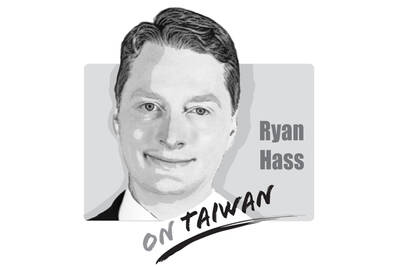China’s property market crunch is making it difficult for local governments to cut an estimated US$6 trillion of hidden debt even as Beijing shows more determination in cracking down on the problem.
Beijing, Shanghai and Guangdong Province are planning trials to eliminate the off-balance sheet borrowing that local authorities use to raise funds for spending. Although there were no details, it is likely the pilot pro grams could eventually be rolled out to more of the 31 other regions in the country.
The central government is getting more serious about tackling financial risks associated with the debt, which it labeled a “national security” issue earlier this year. Authorities must balance the push to fix the problem with efforts to keep record bond defaults and a slowing economy from getting out of hand.

Illustration: Yusha
A downturn in the property market will not make it an easy task. Land sales, which account for about 40 percent of local governments’ revenue, have tumbled since August, putting pressure on public finances. Moody’s Investors Service warns of a potential decline in land sales income and local governments possibly taking on more, not less, debt to fund infrastructure.
Here is a look at what government-linked economists say are the challenges faced in trying to eliminate the debt.
WHAT IS HIDDEN DEBT?
Local governments, under pressure to shore up growth in the wake of the global financial crisis in 2008, went on a borrowing binge to fund infrastructure projects as part of China’s 4 trillion yuan (US$626.85 billion) stimulus package.
Before a new budget law was introduced in 2015, regional authorities were not allowed to borrow directly. Instead, they were encouraged by Beijing to use state-owned companies now known as local government financing vehicles, or LGFVs, to raise money through bank loans, and later, bond issuance.
The debt does not appear on the balance sheets of local governments, yet carries an implicit guarantee of repayment with public money. Most of the debt is owned by local banks, so the surge over the years has led to moral hazard and risks to the financial system.
In a way, the hidden debt is emblematic of China’s old growth model, one that is heavily dependent on investment and debt-fueled urbanization.
HOW BIG IS THE PROBLEM?
Much of the problem lies precisely in the fact that there is no way to ascertain exactly how much debt local governments have accumulated.
The IMF estimates LGFV debt amounted to 39 trillion yuan last year. Goldman Sachs Group Inc puts it at 53 trillion yuan. Using a narrower definition, the state-run National Institution for Finance & Development estimates 15 trillion yuan.
The problem is becoming thornier with the property slump. On the one hand, LGFV bonds have become popular among investors seeking shelter in state-backed assets, following a sell-off in private developers’ bonds. On the other hand, many LGFVs count land as their main assets and declining land sales could hurt their ability to repay debt.
It is also likely Beijing could lean on state firms to help ease property market stress, which may make it even harder to cut down on hidden debt. Local state-owned companies and LGFVs could be called in to help, through for example, buying more land or bailing out firms if needed.
Many regions — especially those in the western hinterland — have been slow in addressing the problem, and could delay efforts if the central government does not roll out the trial programs, said Mao Jie (毛捷), a professor at the University of International Business and Economics, who advises the Chinese Ministry of Finance.
“It’s a systemic challenge” to resolve hidden debt, he said. “Both local governments and the market need to make enormous changes in the way they operate.”
HOW CAN PROVINCES TACKLE IT?
Several options are available, experts said.
‧ Repaying debt with fiscal revenue:
Some cities in Guangdong Province have repaid LGFV debt with public income, and this remains one of the manufacturing hub’s options during its trial, said Wen Laicheng (溫來成), a professor at Central University of Finance and Economics.
Guangdong could probably eliminate its hidden debt within two years, Mao said.
‧ Repaying debt by selling LGFV or government assets or equities:
This could help local governments make more efficient use of assets, even though they will have less resources, said Cui Zhijuan (崔志娟), a professor at Beijing National Accounting Institute, which is under the Ministry of Finance.
‧ Repaying debt with project returns and LGFVs’ profit:
This could only be viable in a few places such as Shanghai, because most LGFVs’ projects are public welfare and have limited returns, Wen said.
‧ Transforming LGFVs into real market entities:
This would turn hidden debt into corporate debt, as LGFVs take on more profit-driven business, such as utility and construction instead of public welfare projects.
‧ Replacing hidden debt with refinancing bonds:
A total of 688 billion yuan of such bonds have been sold as of the end of last month, with the purpose of repaying existing debt, GF Securities Co said. However, the issuance would be restricted by the governments’ debt cap and may take place in Beijing, Shanghai and Jiangsu Province mainly, China Industrial Securities Co.
‧ Restructuring or bankruptcy of LGFVs:
While none of the LGFVs have defaulted so far, provinces — including Jiangsu and Yunnan — have said they will restructure or liquidate LGFVs that have lost repayment capabilities.
Bankruptcies may be a necessary cost to pay in order to reform some LGFVs, while at the same time China needs to guard against any “malicious evasion” of debt repayment by local authorities, Cui said.
WHAT HAS BEEN HAPPENING SO FAR?
China has tried to bring hidden debt under control over the past decade. Here are a few examples of success in different regions:
‧ Shanxi Province merged about three dozen highway builders into one entity, which signed new loan arrangements with banks and reduced interest payments
‧ Shanghai SMI Holding Co is one of the earliest examples of successful LGFV reform, Mao said.
‧ Liaozhong District in the northeastern city of Shenyang repaid 15 million yuan of debt with assets in 2019
‧ Duolun County in Inner Mongolia repaid 600 million yuan of hidden debt with properties they owned
‧ Authorities set up a municipal bond market in 2015 to move financing away from the more opaque LGFV debt.
The trials are likely to expand next year to more cities in less developed regions, such as the western provinces, said Zhang Yiqun (張奕群), a member of the Society of Public Finance of China.
Despite the challenges, the country is likely to cut all hidden debt by 2035, and regions with better finances might be able to achieve that by 2025, he said.
“About half of the debt will be repaid, and the other will be transformed into on-balance-sheet debt,” Zhang said.

There has been much catastrophizing in Taiwan recently about America becoming more unreliable as a bulwark against Chinese pressure. Some of this has been sparked by debates in Washington about whether the United States should defend Taiwan in event of conflict. There also were understandable anxieties about whether President Trump would sacrifice Taiwan’s interests for a trade deal when he sat down with President Xi (習近平) in late October. On top of that, Taiwan’s opposition political leaders have sought to score political points by attacking the Lai (賴清德) administration for mishandling relations with the United States. Part of this budding anxiety
The diplomatic dispute between China and Japan over Japanese Prime Minister Sanae Takaichi’s comments in the Japanese Diet continues to escalate. In a letter to UN Secretary-General Antonio Guterres, China’s UN Ambassador Fu Cong (傅聰) wrote that, “if Japan dares to attempt an armed intervention in the cross-Strait situation, it would be an act of aggression.” There was no indication that Fu was aware of the irony implicit in the complaint. Until this point, Beijing had limited its remonstrations to diplomatic summonses and weaponization of economic levers, such as banning Japanese seafood imports, discouraging Chinese from traveling to Japan or issuing
On Nov. 8, newly elected Chinese Nationalist Party (KMT) Chairwoman Cheng Li-wun (鄭麗文) and Vice Chairman Chi Lin-len (季麟連) attended a memorial for White Terror era victims, during which convicted Chinese Communist Party (CCP) spies such as Wu Shi (吳石) were also honored. Cheng’s participation in the ceremony, which she said was part of her efforts to promote cross-strait reconciliation, has trapped herself and her party into the KMT’s dark past, and risks putting the party back on its old disastrous road. Wu, a lieutenant general who was the Ministry of National Defense’s deputy chief of the general staff, was recruited
Tokyo-Beijing relations have been rapidly deteriorating over the past two weeks as China tries to punish Japan over Japanese Prime Minister Sanae Takaichi’s remarks about Taiwan earlier this month, and the off-ramp to this conflict is yet to be seen. Takaichi saying that a “Taiwan contingency” could cause a “situation threatening Japan’s survival” — which would allow Japan to act in self-defense — has drawn Beijing’s ire and sparked retaliatory measures. Her remark did not gain public attention until Chinese Consul General in Osaka Xue Jian (薛劍) made an apparent threat to behead her. The two sides lodged protests against each